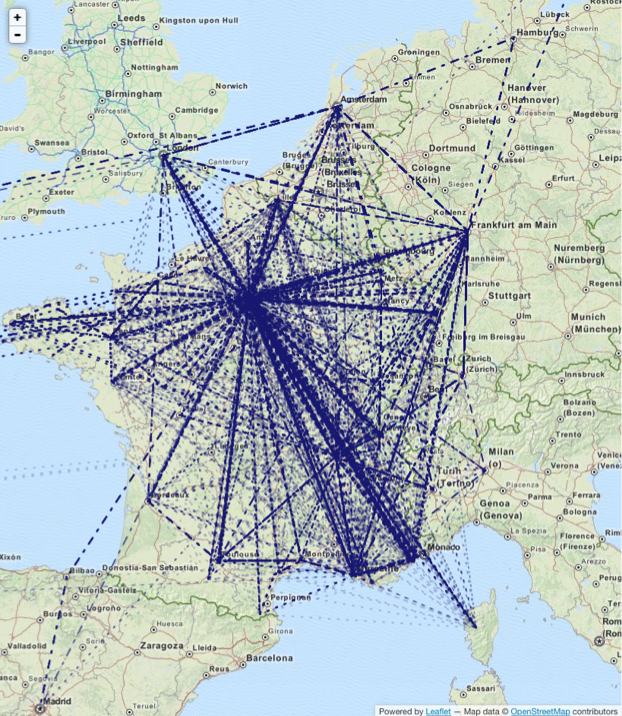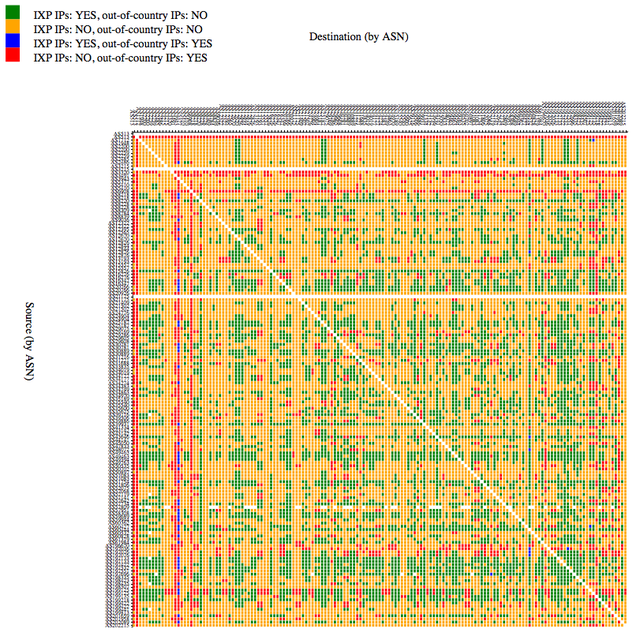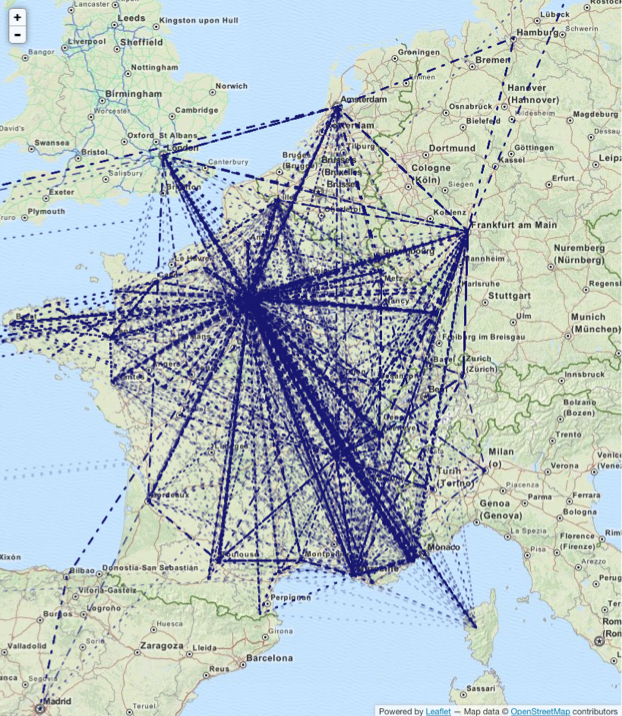This article describes our recent collaborations with France-IX on collecting data plane and control plane Internet data with RIPE Atlas and the RIPE NCC's Routing Information Service (RIS).
New RIS routing collector at France-IX
As announced at RIPE 70, we are currently looking at improvements to the RIPE NCC's Routing Information Service (RIS). This will be described in another RIPE Labs article in more detail. Under this new scheme a RIS route collector (RRC21) has been installed at France-IX . So far 11 out of 16 configured IPv4 peers are up and running and 11 out of 15 peers are up for IPv6. This route collector will be able to collect data at France-IX Paris and Marseille and potentially at their partner IXPs in the future. This multiple Peering LAN setup made it particularly attractive to have one of our new route collectors at France-IX.
RIPE Atlas and France-IX
Currently 755 RIPE Atlas probes and nine
RIPE Atlas anchors
are connected in France. One of these anchors is installed at France-IX.
Measurements from all other RIPE Atlas anchors and hundreds of probes are automatically scheduled towards this anchor. Unlike probes,
RIPE Atlas anchors are easy and stable targets when needed
.
Anchors earn measurement credits at 10x the rate of normal probes, which France-IX can redistribute to its members and others who have a good cause for them.
Example of RIS and RIPE Atlas data analysis
Example uses of RIS and RIPE Atlas data specific for France, and instructions on how to set up measurements, can be found in our presentation at the France-IX AGM .
For example, researchers at ANSSI are using RIS data to detect BGP hijacking of French prefixes in real time, and also use RIPE Atlas to verify their findings.
Measuring France(-IX) with RIPE Atlas
Is France "keeping local traffic local"? We can't answer that question with RIPE Atlas (as it doesn't measure traffic) but we can measure the path between end-points in France. In our case the end-points are RIPE Atlas probes located in France, and we measure the path with traceroute.
The methodology is explained in Measuring Countries and IXPs with RIPE Atlas . The source code is on GitHub , for anybody to use and improve.
Currently 755 RIPE Atlas probes are connected in France, which would be over half a million traceroutes. If we only select up to two probes per ASN, we end up with 23k traceroutes, which is much more manageable, and from which we ask the questions:
- Do we see IXPs in these paths?
-
Do we see out-of-country paths?
And
do they need to be fixed?
IXP traversal
It is important to note that we cooperated with France-IX and therefore we were able to look at their peering LANs in both Paris and Marseille. The numbers we present here are related to this cooperation. However, we could easily extend this to all of the French IXP LANs if we have the right information.
| IPv4 | IPv6 | |
|
France-IX Paris |
27.3% | 33.0% |
|
France-IX Marseille |
1.0% | 0.5% |
Table 1: Percentage of paths that traversed France-IX peering LANs.
Figure 1 below shows a matrix of these traceroutes, where rows and columns are source and destination probes, ordered north to south. Each cell is coloured in blue if France-IX Paris is traversed, or in red if France-IX Marseille is traversed. In the bottom-right of this graph (south-to-south probes) you can see most of the paths are through Marseilles peering LAN, but it's interesting to still see the Paris peering LAN traversed here in some cases. It would be interesting to look into it and see if the networks involved would be better off with a path through the Marseilles LAN.

Figure 1: France-IX peering LANs in Paris (bleu) and Marseille (rouge).
Out-of-country paths
Paths from probes to probes in France that go outside of France are interesting to investigate. There can be valid reasons for such paths. For instance, the collected data contains traceroutes from a probe at CERN that is very close to the Swiss border, where paths are mostly through Geneva in Switzerland. Out-of-country paths could also be caused by sub-optimal routing policies or config errors. These are the paths we'd like to take a closer look at.
For IPv4, we observed out-of-country IP addresses in 9% of the paths, and in 18% for IPv6.
Table 2 below shows a breakdown of the top five countries that are seen in these paths.
| IPv4 | IPv6 | |
| DE | 3.7% | 7.3% |
| CH | 2.7% | 4.5% |
| GB | 2.1% | 3.5% |
| NL | 2.0% | 6.0% |
| IT | 0.8% | 0.7% |
Table 2: Specific countries seen in out-of-country paths between selected probes in France.
Figure 2 below shows the paths between all chosen RIPE Atlas probes in France for IPv4. Note we've left out some paths that went to the USA and back. The full visualisation (which is experimental and might crash browsers!) is available here :

Figure 2: Visualisation of Internet paths between RIPE Atlas probes in France.
IXP and in-country correlation
If IXPs help in keeping local traffic local, it is interesting to look at the correlation between a path going out-of-country and not traversing an IXP. In Figure 3, cells are coloured according to the following four combinations:
- Path via IXP, not going out-of-country (green)
- Path not via IXP, not going out-of-country (orange)
- Path via IXP, going out-of-country (blue)
- Path not via IXP, going out-of-country (red)
The IXP paths that still go out-of-country (blue) are, in this case, caused by a probe on a LISP testbed. For the other paths that go out-of-country the operators in question could look to see if it would make sense for them to improve this, for instance by peering locally. You can find an interactive version of Figure 3 online. In this version one can hover over the cells to see the actual traceroute path, as well as the inferred AS and geolocation.

Figure 3: IXP and out-of-country correlation matrix for France/France-IX.
Conclusion and call for help
This visualisation provides interesting data to number of communities:
- Network operators can e xplore to see where their services can be improved.
- IXP s can use this data to f ind network operators that would benefit from peering.
All the analysis shown in this article used a set of scripts that I put on GitHub as the
IXP-Country-Jedi
.
Please c
heck out the code and improve it
.
Feature requests are also welcome! We are working on automatically creating these analyses for all countries where we have enough RIPE Atlas coverage.
The RIPE NCC is happy to work together with organisations like France-IX on measurement projects like this and/or present on them at local meetings. The slidedeck that was presented at the France-IX AGM is available
here
. Please don't hesitate to contact us (labs [at] ripe [dot] net) if you are interested in possible collaborations like this.





Comments 2
The comments section is closed for articles published more than a year ago. If you'd like to inform us of any issues, please contact us.
seyed marashi •
WellDone RIPE!!!
wow!!! •
WOW!!! very usefull!!! THANX=)